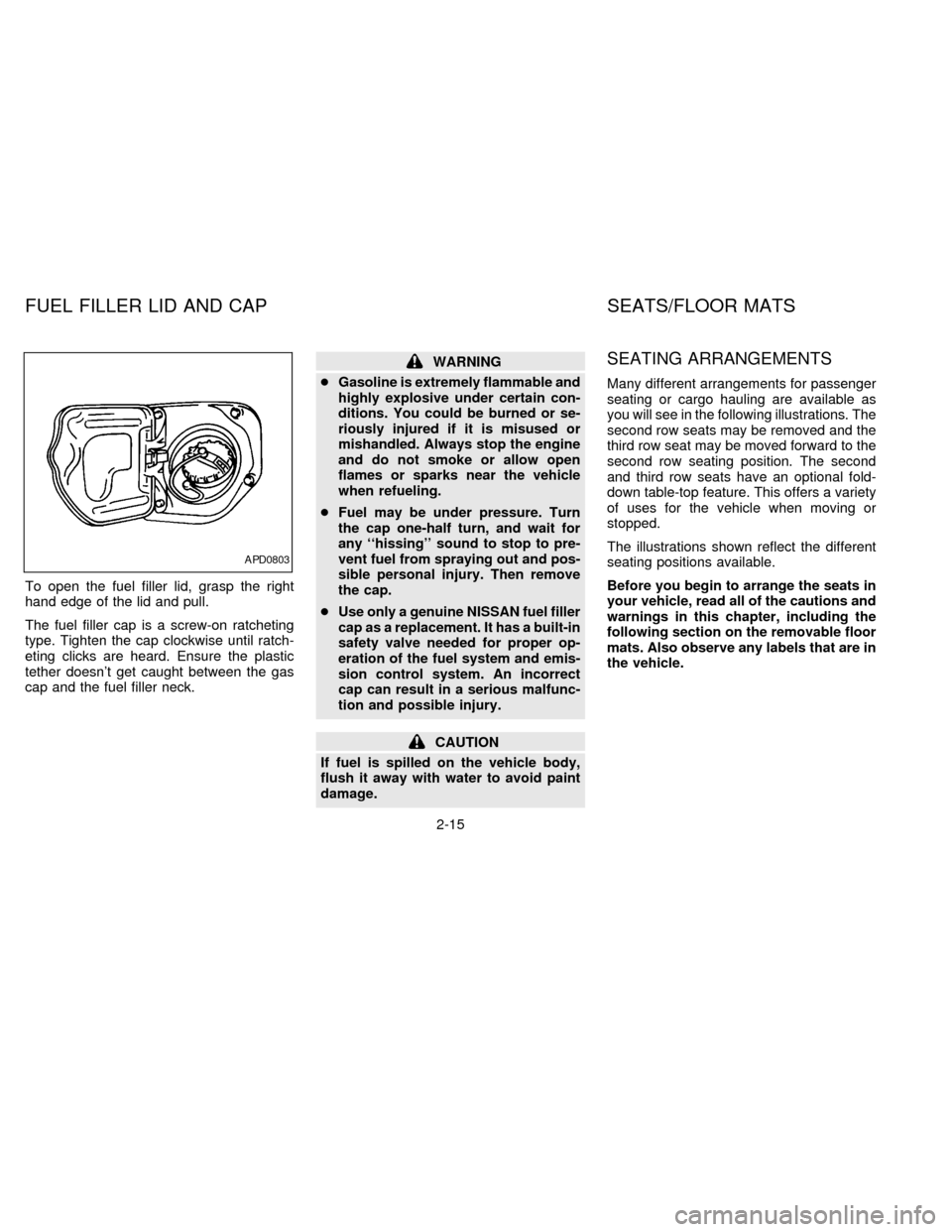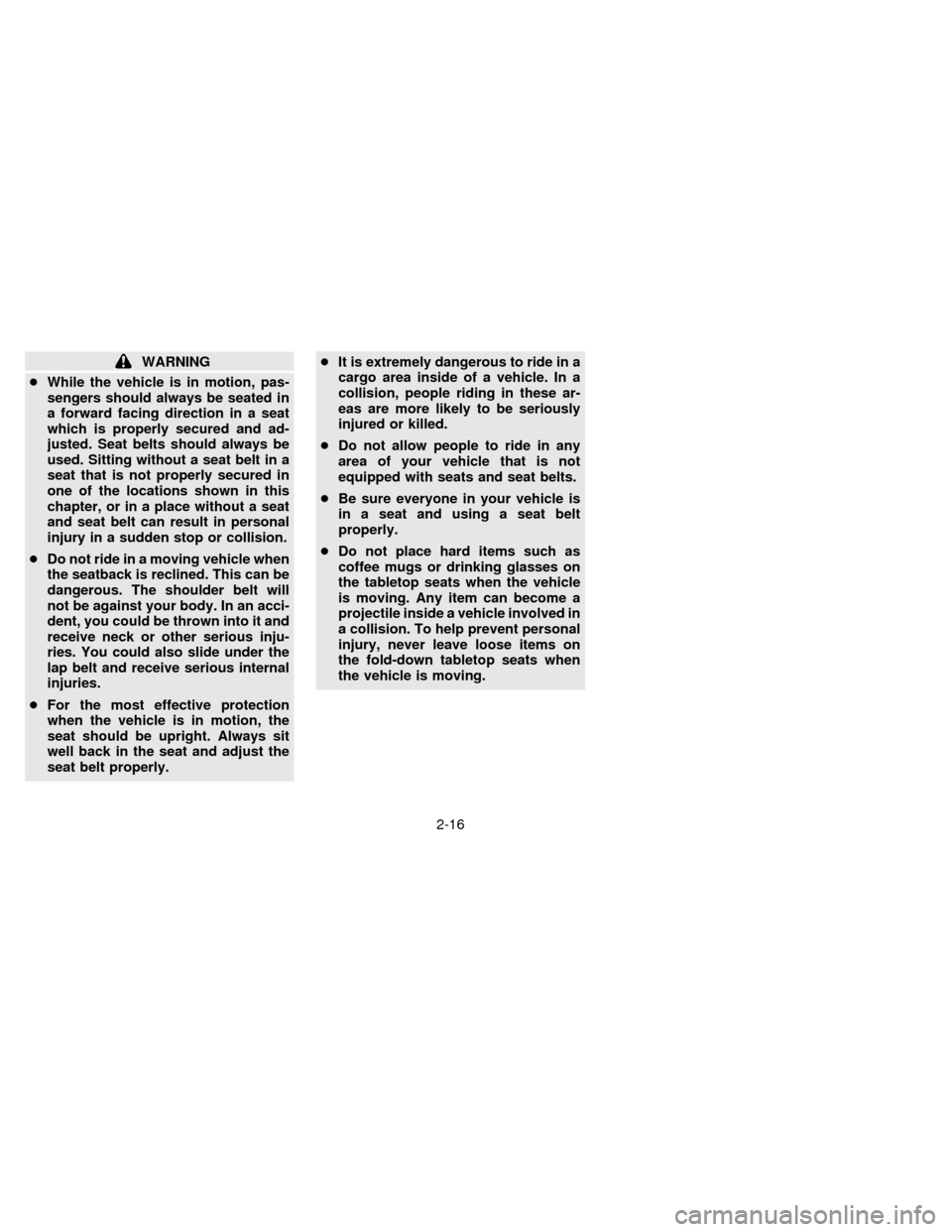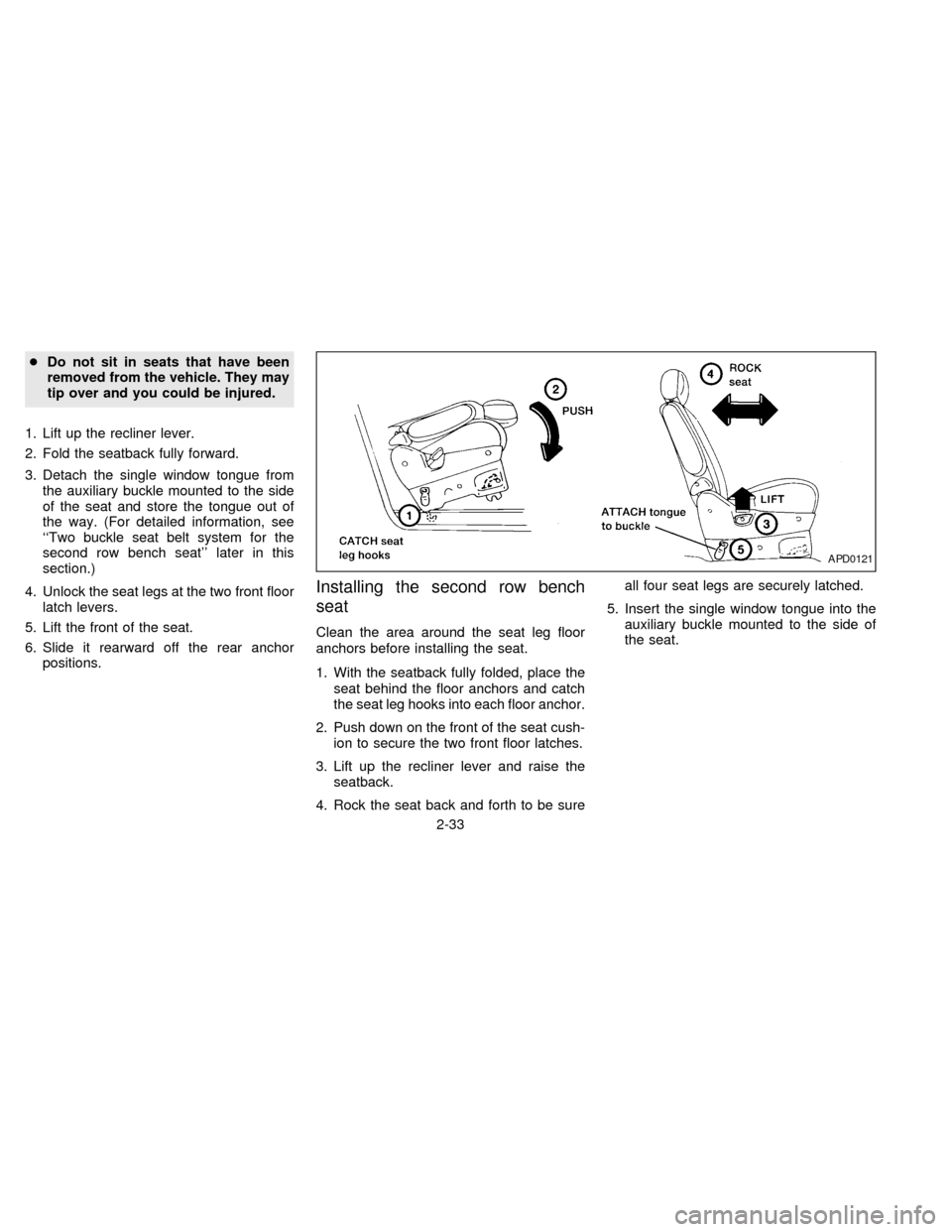Page 48 of 247

To open the fuel filler lid, grasp the right
hand edge of the lid and pull.
The fuel filler cap is a screw-on ratcheting
type. Tighten the cap clockwise until ratch-
eting clicks are heard. Ensure the plastic
tether doesn't get caught between the gas
cap and the fuel filler neck.
WARNING
cGasoline is extremely flammable and
highly explosive under certain con-
ditions. You could be burned or se-
riously injured if it is misused or
mishandled. Always stop the engine
and do not smoke or allow open
flames or sparks near the vehicle
when refueling.
cFuel may be under pressure. Turn
the cap one-half turn, and wait for
any ``hissing'' sound to stop to pre-
vent fuel from spraying out and pos-
sible personal injury. Then remove
the cap.
cUse only a genuine NISSAN fuel filler
cap as a replacement. It has a built-in
safety valve needed for proper op-
eration of the fuel system and emis-
sion control system. An incorrect
cap can result in a serious malfunc-
tion and possible injury.
CAUTION
If fuel is spilled on the vehicle body,
flush it away with water to avoid paint
damage.
SEATING ARRANGEMENTS
Many different arrangements for passenger
seating or cargo hauling are available as
you will see in the following illustrations. The
second row seats may be removed and the
third row seat may be moved forward to the
second row seating position. The second
and third row seats have an optional fold-
down table-top feature. This offers a variety
of uses for the vehicle when moving or
stopped.
The illustrations shown reflect the different
seating positions available.
Before you begin to arrange the seats in
your vehicle, read all of the cautions and
warnings in this chapter, including the
following section on the removable floor
mats. Also observe any labels that are in
the vehicle.
APD0803
FUEL FILLER LID AND CAP SEATS/FLOOR MATS
2-15
ZX
Page 49 of 247

WARNING
cWhile the vehicle is in motion, pas-
sengers should always be seated in
a forward facing direction in a seat
which is properly secured and ad-
justed. Seat belts should always be
used. Sitting without a seat belt in a
seat that is not properly secured in
one of the locations shown in this
chapter, or in a place without a seat
and seat belt can result in personal
injury in a sudden stop or collision.
cDo not ride in a moving vehicle when
the seatback is reclined. This can be
dangerous. The shoulder belt will
not be against your body. In an acci-
dent, you could be thrown into it and
receive neck or other serious inju-
ries. You could also slide under the
lap belt and receive serious internal
injuries.
cFor the most effective protection
when the vehicle is in motion, the
seat should be upright. Always sit
well back in the seat and adjust the
seat belt properly.cIt is extremely dangerous to ride in a
cargo area inside of a vehicle. In a
collision, people riding in these ar-
eas are more likely to be seriously
injured or killed.
cDo not allow people to ride in any
area of your vehicle that is not
equipped with seats and seat belts.
cBe sure everyone in your vehicle is
in a seat and using a seat belt
properly.
cDo not place hard items such as
coffee mugs or drinking glasses on
the tabletop seats when the vehicle
is moving. Any item can become a
projectile inside a vehicle involved in
a collision. To help prevent personal
injury, never leave loose items on
the fold-down tabletop seats when
the vehicle is moving.
2-16
ZX
Page 54 of 247
WITH SECOND ROW BENCH
SEAT
The most common seating arrangement for
seven passengers is with the three-
passenger bench seat in seating position
#1. This provides more leg room for the
passengers sitting in the third row.When more cargo area room is necessary,
the three-passenger sliding bench seat can
be moved to seating position #2. This seat-
ing arrangement provides less leg room for
third row passengers, but more cargo area
room.The fold-down tabletop seats in the second
and third rows provide a surface for eating
or playing games on long trips.
APD0096APD0097APD0042
SEAT POSITIONS
2-21
ZX
Page 55 of 247
If a considerable amount of cargo area
room is needed, the seat cushion of the
three-passenger sliding bench seat can be
flipped up and the seat can be moved up to
storage position #2, just behind the second
row seat.When maximum cargo area is needed and
there are no rear seat passengers, the
second row seat can be removed and the
three-passenger sliding bench seat can be
moved up to storage position #1, just behind
the front seats.The second row bench seat can be folded
down to serve as a tabletop for passengers
sitting in the three-passenger bench seat.
APD0043APD0049APD0044
2-22
ZX
Page 56 of 247
The second and third row bench seats can
be folded down to tabletops.To increase cargo area space, the second
row bench seat can be removed and the
three-passenger sliding seat can be moved
up to the second row position.The third seat can be folded down into a
tabletop.
APD0045APD0046APD0047
2-23
ZX
Page 57 of 247
With the third seat folded down and the
second seat removed, cargo can be placed
in between the front seats and the third row
seat.People should not be allowed to
ride in areas meant for cargo. Passen-
gers should always be properly re-
strained in seat belts.The second row seat can be folded down
and the third row seat can be moved just
behind it in a storage position.WITH SECOND ROW BUCKET
SEATS
The normal seating arrangement for seven
passengers is with the three-passenger
bench seat in seating position #1. This
provides more leg room for the passengers
sitting in the third row.
APD0048APD0050APD0128
2-24
ZX
Page 64 of 247
UNDERSEAT STORAGE TRAY
Some front passenger seats have an under-
seat storage tray.
TABLETOP SEATS
The second and third row seats convert into
tabletops with built-in cupholders. To use
the tabletop seats, lift up on the seatback
release lever and fold the seatback forward.
WARNING
cNever place hard items such as cof-
fee mugs or drinking glasses on the
tabletop seats when the vehicle is
moving. Any item can become a pro-
jectile inside a vehicle involved in a
collision. To help prevent personal
injury, never leave loose items on
the folded-down tabletop seats when
the vehicle is moving.
cDo not use the tabletop and cup
holder feature while the vehicle is in
motion unless you are properly
seated with your seat belt on.
APD0811
APD0129
2-31
ZX
Page 66 of 247

cDo not sit in seats that have been
removed from the vehicle. They may
tip over and you could be injured.
1. Lift up the recliner lever.
2. Fold the seatback fully forward.
3. Detach the single window tongue from
the auxiliary buckle mounted to the side
of the seat and store the tongue out of
the way. (For detailed information, see
``Two buckle seat belt system for the
second row bench seat'' later in this
section.)
4. Unlock the seat legs at the two front floor
latch levers.
5. Lift the front of the seat.
6. Slide it rearward off the rear anchor
positions.
Installing the second row bench
seat
Clean the area around the seat leg floor
anchors before installing the seat.
1. With the seatback fully folded, place the
seat behind the floor anchors and catch
the seat leg hooks into each floor anchor.
2. Push down on the front of the seat cush-
ion to secure the two front floor latches.
3. Lift up the recliner lever and raise the
seatback.
4. Rock the seat back and forth to be sureall four seat legs are securely latched.
5. Insert the single window tongue into the
auxiliary buckle mounted to the side of
the seat.
APD0121
2-33
ZX